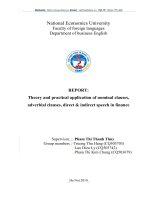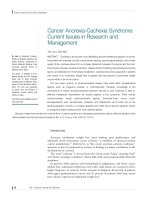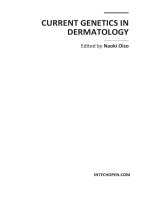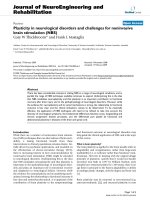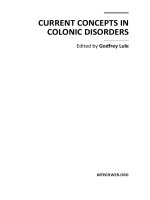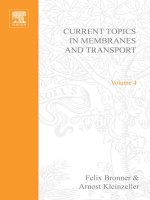Transcranial direct current stimulation in neuropsychiatric disorders
Bạn đang xem bản rút gọn của tài liệu. Xem và tải ngay bản đầy đủ của tài liệu tại đây (10.2 MB, 421 trang )
Transcranial Direct
Current Stimulation
in Neuropsychiatric
Disorders
Clinical Principles
and Management
André Brunoni
Michael Nitsche
Colleen Loo
Editors
123
Transcranial Direct Current Stimulation
in Neuropsychiatric Disorders
André Brunoni • Michael Nitsche
Colleen Loo
Editors
Transcranial Direct
Current Stimulation
in Neuropsychiatric
Disorders
Clinical Principles and Management
Editors
André Brunoni
Interdisciplinary Center for Applied
Neuromodulation
University Hospital and Service of
Interdisciplinary Neuromodulation
Department and Institute of Psychiatry
Laboratory of Neurosciences (LIM-27)
University of São Paulo
São Paulo, Brazil
Michael Nitsche
Department of Psychology and
Neurosciences
Leibniz Research Center for Working
Environments and Human Factors
Dortmund, Germany
Colleen Loo
School of Psychiatry
Black Dog Institute & St George
Hospital
University of New South Wales
Sydney, NSW, Australia
ISBN 978-3-319-33965-8
ISBN 978-3-319-33967-2
DOI 10.1007/978-3-319-33967-2
(eBook)
Library of Congress Control Number: 2016951923
© Springer International Publishing Switzerland 2016
This work is subject to copyright. All rights are reserved by the Publisher, whether the whole or
part of the material is concerned, specifically the rights of translation, reprinting, reuse of
illustrations, recitation, broadcasting, reproduction on microfilms or in any other physical way,
and transmission or information storage and retrieval, electronic adaptation, computer software,
or by similar or dissimilar methodology now known or hereafter developed.
The use of general descriptive names, registered names, trademarks, service marks, etc. in this
publication does not imply, even in the absence of a specific statement, that such names are
exempt from the relevant protective laws and regulations and therefore free for general use.
The publisher, the authors and the editors are safe to assume that the advice and information in
this book are believed to be true and accurate at the date of publication. Neither the publisher nor
the authors or the editors give a warranty, express or implied, with respect to the material
contained herein or for any errors or omissions that may have been made.
Printed on acid-free paper
This Springer imprint is published by Springer Nature
The registered company is Springer International Publishing AG Switzerland
Foreword
Why write a book on transcranial direct current stimulation (tDCS)? This
question is especially relevant in the face of the rapidly increasing numbers
of journals, open access publications, wikis and blogs. In parallel to the exponential spread of information sources, information and beliefs also tend to be
found in shared virtual spaces, where they are amplified and reinforced.
Critical reflection on concurrent and opposing opinions, or a synopsis of such
opinions, is underrepresented in such “echo chambers”. This is the case for
the general public discourse and may also be true for the reception of scientific findings.
tDCS is a technically extremely simple method and easy to apply. Thus,
people can be tempted to build the equipment themselves or try do-it-yourself
(DIY) application without any expert guidance—numerous video clips for
DIY tDCS on the web are just one form of public sharing of knowledge and
convictions about this method that are echoed by other followers. People are
also tempted to follow intuitive attitudes or convictions about tDCS, e.g. nonverified dose/parameter response assumptions, hypotheses on the functional
anatomy of tDCS effects or a general idea of reinforcing brain functions with
no side effects (cognitive enhancement). The 2016 paper “tDCS modulates
neuronal activity and learning in pilot training” [1] is just one example where
the title immediately and strongly suggests an application in real-world settings. Karl R. Popper’s general rule, however, “that we are not to abandon the
search for universal laws and for coherent theoretical system, nor ever give up
our attempts to explain causally any kind of event we can describe” [2], which
he proposed to be closely associated with the “principle of causality”, should
remind us to be careful about making assumptions. Admittedly, though, we
often follow associative or correlative relations, particularly when applying
insights from neuroscience to clinical situations.
Of course, a single book cannot counterbalance or overrule current trends
in a scientific discussion. Moreover dispersed, “open access” pieces of data
and information are also extremely valuable in a thorough discussion of scientific findings. Nevertheless, because this book combines a critical amount
of data and hypotheses it allows the reader to appraise findings and theories
on tDCS and its variants.
Andre Brunoni, Michael Nitsche, Colleen Loo and the other authors, all
pioneers and leading experts in the field, have taken a brilliant approach to
this endeavour and guide us through the state of the art in tDCS. The different
chapters cover tDCS development, related technologies (e.g. transcranial
v
Foreword
vi
alternating current stimulation, tACS, or transcranial random noise stimulation, tRNS), physiology and translational research from animal experiments
to preclinical studies in humans involving neurocognitive and neuropsychological approaches, electroencephalography and magnetic resonance imaging
(MRI). Several chapters cover specific applications ranging from cerebellar
and spinal tDCS to different applications in neuropsychiatric disorders. The
final part of the book outlines and discusses safety-related, ethical and regulatory issues.
tDCS is part of the armamentarium of non-invasive brain stimulation
(NIBS), which constitutes a growing array of techniques such as transcranial
magnetic stimulation (TMS), paired associative stimulation (PAS) and transcutaneous vagal nerve stimulation.
Each NIBS technique, but also each variant of tDCS, is a neurophysiologically distinct method. The authors of this book are aware that tDCS is used as
a non-focal approach on the most complex organ/system of the human body
and that the differential action of tDCS on single neurons or neuronal circuits
or glial cells is difficult to predict or target. Dose-response curves often show
non-linear functions, which are currently not fully understood. Furthermore,
dynamic effects of repeated tDCS administration, which are particularly
important for therapeutic applications, still need to be elucidated. The combination of tDCS with psychotherapy and other interventions is currently being
tested in pilot studies and is proving to be extremely challenging [3]. Such
open methodological fields would provide a large experimental terrain for
preclinical studies in cellular and animal models, but studies in this preclinical field are still underrepresented. Thus, the book may stimulate the transfer
of research based on clinical or experimental data in humans to the preclinical
field of cellular or animal research strategies (reverse translation).
This book is comprehensive and as such valuable. The task of preparing it
motivated the editors and authors to move systematically through the field of
research and to also cover topics which are not on the main track, e.g. the
history of tDCS and ethical and regulatory issues. Consequently the content
of chapters may overlap, as a reflection of different perspectives. This book
allows the reader to jump between chapters to compare information, hypotheses and views. It is an excellent resource for senior and junior scientists,
doctorate students and others to introduce them to this fascinating field of
research.
Frank Padberg
References
1. Choe J, Coffman BA, Bergstedt DT, Ziegler MD, Phillips ME. Transcranial direct current stimulation modulates neuronal activity and learning in pilot training. Front Hum
Neurosci. 2016;10:34. doi:10.3389/fnhum.2016.00034.
2. Popper KR. The logic of scientific discovery. 11th impression rev. London: Hutchinson
& Co. Publishers Ltd.; 1959. p. 61.
3. Bajbouj M, Padberg F. A perfect match: noninvasive brain stimulation and psychotherapy. Eur Arch Psychiatry Clin Neurosci. 2014;264 Suppl 1:S27–33.
Preface
The clinical interest in non-invasive brain stimulation has grown exponentially over the past 25 years, with the development of non-pharmacological,
neuromodulatory techniques such as repetitive transcranial magnetic stimulation (rTMS) and transcranial direct current stimulation (tDCS). TDCS, the
youngest sibling of the brain stimulation family, is in fact a “new old technique”. With anecdotal reports of the use of the torpedo fish to treat pain and
headache via its electrical discharges during the ancient history, electricity
was indeed used in the nineteenth and twentieth centuries to treat several
neurologic and psychiatric ailments, usually with sparse scientific foundations. Although more recently, in the 1960s and 1970s, the treatment of some
psychiatric disorders was investigated using brain polarization (a technique
similar to modern tDCS), the research did not endure—perhaps due to the
stigma of electroconvulsive therapy or the concomitant development of pharmacotherapy in that period. TDCS reappraisal only took place in 1998–2000,
when two independent European groups showed that the electric currents
applied over the motor cortex induced changes in brain excitability. From
then onwards, tDCS has been increasingly investigated and has attracted considerable attention in both basic and clinical research settings.
In the present book we aimed to present the main advancements regarding
the use of tDCS in neuropsychiatric disorders. The book is divided into three
parts. The first part discusses the mechanisms of action of tDCS under different perspectives, which encompass neurophysiological, neuroimaging and
neuropsychological studies as well as animal studies and computer-based
models. In the second part, state-or-the-art evidence of tDCS use in several
neurological and psychiatric disorders is presented. The third and last part of
the book discusses different possibilities of the clinical and research use of
tDCS, including safety, ethical and regulatory aspects.
This book would not have been produced without the invaluable contribution of leading researchers and scientists of the field. We are grateful and
thank these authors for their time and effort in writing informative, insightful
and up-to-date chapters. We are also grateful to Springer for supporting our
project, particularly Gabriel Natan Pires, the Springer associate editor who
encouraged us to edit this book, and Susan Westendorf, the Springer project
coordinator responsible for this book production.
We believe that this book will be useful to neurologists, psychiatrists and
physicians interested in the potential clinical applications of tDCS. This book
will also be of interest for neophytes, who are looking for a primer in
vii
Preface
viii
non-invasive brain stimulation. More experienced researchers will also enjoy
reading this book as it contains top-quality work written by several tDCS
experts. We, the editors, are convinced that Transcranial Direct Current
Stimulation in Neuropsychiatric Disorders: Clinical Principles and
Management will be a captivating bedside book for many researchers in the
field—us included.
São Paulo, Brazil
Dortmund, Germany
Sydney, NSW, Australia
Andre Brunoni
Michael Nitsche
Colleen Loo
Contents
Part I
Introduction and Mechanisms of Action
1
Historical Aspects of Transcranial Electric Stimulation ..........
Stefano Zago, Alberto Priori, Roberta Ferrucci,
and Lorenzo Lorusso
2
The New Modalities of Transcranial Electric
Stimulation: tACS, tRNS, and Other Approaches ....................
Andrea Antal, Ivan Alekseichuk, and Walter Paulus
21
Physiology of Transcranial Direct and Alternating
Current Stimulation.....................................................................
Min-Fang Kuo, Rafael Polanía, and Michael Nitsche
29
3
4
Computer-Based Models of tDCS and tACS .............................
Dennis Q. Truong, Devin Adair, and Marom Bikson
5
Animal Studies in the Field of Transcranial
Electric Stimulation .....................................................................
Doris Ling, Asif Rahman, Mark Jackson, and Marom Bikson
6
Cortical Inhibition and Excitation in Neuropsychiatric
Disorders Using Transcranial Magnetic Stimulation ...............
Natasha Radhu, Daniel M. Blumberger,
and Zafiris J. Daskalakis
7
Neurocognitive Effects of tDCS in the Healthy Brain ..............
Siobhán Harty, Anna-Katharine Brem, and Roi Cohen Kadosh
8
Transcranial Direct Current Stimulation in Social
and Emotion Research .................................................................
Paulo Sérgio Boggio, Gabriel Gaudencio Rêgo,
Lucas Murrins Marques, and Thiago Leiros Costa
9
10
Multimodal Association of tDCS
with Electroencephalography .....................................................
Nadia Bolognini and Carlo Miniussi
tDCS and Magnetic Resonance Imaging ...................................
Ainslie Johnstone, Emily Hinson, and Charlotte J. Stagg
3
47
67
85
103
143
153
169
ix
Contents
x
11
12
Target Engagement with Transcranial
Current Stimulation.....................................................................
Flavio Fröhlich, Sankaraleengam Alagapan,
Michael R. Boyle, Franz Hamilton, Guoshi Li,
Caroline Lustenberger, and Stephen L. Schmidt
Cerebellar and Spinal tDCS ........................................................
Roberta Ferrucci, Tommaso Bocci, and Alberto Priori
197
223
Part II Applications of tDCS in Neuropsychiatric Disorders
13
Mood Disorders ............................................................................
André Brunoni and Colleen Loo
233
14
Schizophrenia ...............................................................................
Marine Mondino, Clara Fonteneau, and Jérôme Brunelin
245
15
OCD, Anxiety Disorders, and PTSD ..........................................
Giordano D’Urso, Teresa Sassi, Andrea de Bartolomeis,
and Antonio Mantovani
265
16
Neurodegenerative Cognitive Disorders ....................................
Tarek K. Rajji
273
17
Impulsivity and Substance-Use Disorders .................................
Sara Labbe and Shirley Fecteau
281
18
Epilepsy .........................................................................................
Sameer C. Dhamne, Yan Sun, and Alexander Rotenberg
293
19
Pain Syndromes ............................................................................
Alexandre F.M. DaSilva and Marcos Fabio DosSantos
299
20
Stroke ............................................................................................
Nam-Jong Paik and Won-Seok Kim
315
21
Transcranial Direct Current Stimulation in Disorders
of Consciousness ...........................................................................
Thibaut Aurore, Di Perri Carol, and Laureys Steven
329
Part III The Clinical Use of tDCS
22
Safety and Tolerability.................................................................
André Brunoni, Colleen Loo, and Michael Nitsche
23
Home-Based tDCS: Design, Feasibility
and Safety Considerations...........................................................
Angelo Alonzo and Leigh Charvet
351
Ethical Aspects of tDCS Use in Neuropsychiatry
and the Risk of Misuse.................................................................
Rachel P. Wurzman and Roy H. Hamilton
363
24
343
Contents
xi
25
Regulatory Aspects.......................................................................
Alejandra Vasquez and Felipe Fregni
383
26
Clinical Research and Methodological Aspects
for tDCS Research .......................................................................
Adam J. Woods and Donel M. Martin
393
Index ......................................................................................................
405
Contributors
Devin Adair Department of Psychology, The Graduate Center, The City
University of New York, New York, NY, USA
Sankaraleengam Alagapan Department of Psychiatry, University of North
Carolina at Chapel Hill, Chapel Hill, NC, USA
Ivan Alekseichuk Department of Clinical Neurophysiology, University
Medical Center Göttingen, Göttingen, Germany
Angelo Alonzo School of Psychiatry, Black Dog Institute, University of
New South Wales, Sydney, NSW, Australia
Andrea Antal Department of Clinical Neurophysiology, University Medical
Center Göttingen, Göttingen, Germany
Thibaut Aurore Coma Science Group, GIGA-Research, Cyclotron
Research Center, University and University Hospital of Liège, Liege, Belgium
Laboratory of Neuromodulation, Department of Physical Medicine &
Rehabilitation, Spaulding Rehabilitation Hospital, Harvard Medical School,
Boston, MA, USA
Andrea de Bartolomeis Department of Neurosciences, Reproductive and
Odontostomatological Sciences, University of Naples Federico II, Naples,
Italy
Marom Bikson Department of Biomedical Engineering, The City College
of New York, The City University of New York, New York, NY, USA
Daniel M. Blumberger Temerty Centre for Therapeutic Brain Intervention,
Centre for Addiction and Mental Health, University of Toronto, Toronto, ON,
Canada
Tommaso Bocci Dipartimento di Medicina Clinica e Sperimentale,
Università degli Studi di Pisa, Pisa, Italy
Paulo Sérgio Boggio Social and Cognitive Neuroscience Laboratory and
Developmental Disorders Program, Mackenzie Presbyterian University,
Center for Health and Biological Sciences, Sao Paulo, SP, Brazil
Nadia Bolognini Department of Psychology, University of Milano-Bicocca,
Milano, Italy
xiii
xiv
Neuropsychological Laboratory, IRCCS Istituto Auxologico Italiano, Milano,
Italy
Michael R. Boyle Department of Psychiatry, University of North Carolina at
Chapel Hill, Chapel Hill, NC, USA
Anna-Katharine Brem Department of Experimental Psychology, University
of Oxford, Oxford, UK
Jérôme Brunelin Centre Interdisciplinaire de Recherche en Réadaptation et
en Intégration Sociale, Université Laval, Québec City, QC, Canada
INSERM, U1028, CNRS, UMR5292, Lyon Neuroscience Research Center,
ΨR2 Team, Lyon, France
Centre Hospitalier Le Vinatier, University Lyon 1, Villeurbanne, France
André Brunoni Interdisciplinary Center for Applied Neuromodulation,
University Hospital & Service of Interdisciplinary Neuromodulation,
Department and Institute of Psychiatry, Laboratory of Neurosciences (LIM-27),
University of São Paulo, São Paulo, Brazil
Di Perri Carol Coma Science Group, GIGA-Research, Cyclotron Research
Center, University and University Hospital of Liège, Liege, Belgium
Leigh Charvet Department of Neurology, Multiple Sclerosis Comprehensive
Care Center, New York University School of Medicine, New York, NY, USA
Thiago Leiros Costa Social and Cognitive Neuroscience Laboratory and
Developmental Disorders Program, Mackenzie Presbyterian University,
Center for Health and Biological Sciences, Sao Paulo, SP, Brazil
Giordano D’Urso Department of Clinical Neurosciences, Anesthesiology
and Pharmachoutilization, University Hospital Federico II, Naples, Italy
Alexandre F.M. DaSilva Headache & Orofacial Pain Effort (H.O.P.E.),
Department of Biologic and Materials Sciences, School of Dentistry,
University of Michigan, Ann Arbor, MI, USA
Center for Human Growth and Development, University of Michigan, Ann
Arbor, MI, USA
The Molecular & Behavioral Neuroscience Institute (MBNI), University of
Michigan, Ann Arbor, MI, USA
Zafiris J. Daskalakis Temerty Centre for Therapeutic Brain Intervention,
Centre for Addiction and Mental Health, University of Toronto, Toronto, ON,
Canada
Sameer C. Dhamne Division of Epilepsy and Clinical Neurophysiology
and F.F. Kirby Neurobiology Center, Department of Neurology, Boston
Children’s Hospital, Boston, MA, USA
Marcos Fabio DosSantos Universidade Federal do Rio de Janeiro (UFRJ),
RJ, Brazil
Headache & Orofacial Pain Effort (H.O.P.E.), Department of Biologic and
Materials Sciences, School of Dentistry, University of Michigan, Ann Arbor,
MI, USA
Contributors
Contributors
xv
Shirley Fecteau Centre Interdisciplinaire de Recherche en Readaptation et
Integration Sociale, Centre de Recherche Universitaire en Sante Mentale de
Quebec (CIRRIS), Faculte de Medecine, Universite Laval, Quebec City, QC,
Canada
Roberta Ferrucci Centro Clinico per la Neurostimolazione, le
Neurotecnologie e i Disordini del Movimento, U.O.C. di Neurofisiopatologia,
Fondazione IRCCS Ca’ Granda Ospedale Maggiore Policlinico, Università
degli Studi di Milan, Milano, Milan, Italy
Clara Fonteneau INSERM, U1028, CNRS, UMR5292, Lyon Neuroscience
Research Center, ΨR2 Team, Lyon, France
Centre Hospitalier Le Vinatier, University Lyon 1, Villeurbanne, France
Felipe Fregni Spaulding Neuromodulation Center, Spaulding Rehabilitation
Hospital, Harvard Medical School, Boston, MA, USA
Flavio Fröhlich Department of Psychiatry, University of North Carolina at
Chapel Hill, Chapel Hill, NC, USA
Department of Cell Biology and Physiology, University of North Carolina at
Chapel Hill, Chapel Hill, NC, USA
Joint Department of Biomedical Engineering, University of North Carolina at
Chapel Hill and North Carolina State University, Chapel Hill, NC, USA
Neuroscience Center, University of North Carolina at Chapel Hill, Chapel
Hill, NC, USA
Department of Neurology, University of North Carolina at Chapel Hill,
Chapel Hill, NC, USA
Franz Hamilton Department of Psychiatry, University of North Carolina at
Chapel Hill, Chapel Hill, NC, USA
Department of Mathematics, North Carolina State University, Raleigh, NC,
USA
Roy H. Hamilton Department of Neurology, University of Pennsylvania,
Philadelphia, PA, USA
Department of Physical Medicine & Rehabilitation, University of
Pennsylvania, Philadelphia, PA, USA
Siobhán Harty Department of Experimental Psychology, University of
Oxford, Oxford, UK
Emily Hinson Oxford Centre for Functional MRI of the Brain (FMRIB),
Department of Clinical Neurosciences, University of Oxford, Oxford, UK
Oxford Centre for Human Brain Activity (OHBA), Department of Psychiatry,
University of Oxford, Oxford, UK
Mark Jackson Department of Biomedical Engineering, The City College of
New York, The City University of New York, New York, NY, USA
Ainslie Johnstone Oxford Centre for Functional MRI of the Brain (FMRIB),
Department of Clinical Neurosciences, University of Oxford, Oxford, UK
xvi
Roi Cohen Kadosh Department of Experimental Psychology, University of
Oxford, Oxford, UK
Won-Seok Kim Department of Rehabilitation Medicine, Seoul National
University College of Medicine, Seoul National University Bundang Hospital,
Seongnam, South Korea
Min-Fang Kuo Department of Psychology and Neurosciences, Leibniz
Research Center for Working Environments and Human Factors, Dortmund,
Germany
Sara Labbe Centre Interdisciplinaire de Recherche en Réadaptation et
Intégration Sociale, Centre de Recherche Universitaire en Santé Mentale de
Québec (CIRRIS), Faculté de médecine, Université Laval, Quebec City, QC,
Canada
Guoshi Li Department of Psychiatry, University of North Carolina at Chapel
Hill, Chapel Hill, NC, USA
Doris Ling Department of Biomedical Engineering, The City College of
New York, The City University of New York, New York, NY, USA
Colleen Loo School of Psychiatry, Black Dog Institute & St George Hospital,
University of New South Wales, Sydney, NSW, Australia
Lorenzo Lorusso Unità Operativa Neurologia, A.S.S.T. Franciacorta,
Chiari, Brescia, Italy
Caroline Lustenberger Department of Psychiatry, University of North
Carolina at Chapel Hill, Chapel Hill, NC, USA
Antonio Mantovani Department of Physiology, Pharmacology &
Neuroscience, Sophie Davis School of Biomedical Education, City University
of New York, New York, NY, USA
Division of Experimental Therapeutics, Department of Psychiatry, Columbia
University/New York State Psychiatric Institute, New York, NY, USA
Lucas Murrins Marques Social and Cognitive Neuroscience Laboratory
and Developmental Disorders Program, Mackenzie Presbyterian University,
Center for Health and Biological Sciences, Sao Paulo, SP, Brazil
Donel M. Martin Sydney Neurostimulation Centre (SyNC), School of
Psychiatry, The University of New South Wales, Sydney, NSW, Australia
Carlo Miniussi Center for Mind/Brain Sciences (CIMeC), University of
Trento, TN, Italy
Cognitive Neuroscience Section, IRCCS Centro San Giovanni di Dio
Fatebenefratelli, Brescia, Italy
Marine Mondino Centre Interdisciplinaire de Recherche en Réadaptation et
en Intégration Sociale, Université Laval, Québec, QC, Canada
Centre de Recherche de l’Institut Universitaire en Santé Mentale de Québec,
Université Laval, Québec City, QC, Canada
Contributors
Contributors
xvii
Michael Nitsche Department of Psychology and Neurosciences, Leibniz
Research Center for Working Environments and Human Factors, Dortmund,
Germany
Nam-Jong Paik Department of Rehabilitation Medicine, Seoul National
University College of Medicine, Seoul National University Bundang Hospital,
Seongnam, South Korea
Walter Paulus Department of Clinical Neurophysiology, University Medical
Center Göttingen, Göttingen, Germany
Rafael Polanía Department of Clinical Neurophysiology, Georg-August
University of Göttingen, Göttingen, Germany
Alberto Priori Dipartimento di Neuroscienze, Scienze della Salute, III
Clinica Neurologica, Polo Ospedaliero San Paolo, Università degli Studi di
Milano, Milan, Italy
Natasha Radhu Temerty Centre for Therapeutic Brain Intervention, Centre
for Addiction and Mental Health, University of Toronto, Toronto, ON,
Canada
Asif Rahman Department of Biomedical Engineering, The City College of
New York, The City University of New York, New York, NY, USA
Tarek K. Rajji Center for Addiction and Mental Health, Toronto, ON,
Canada
Gabriel Gaudencio Rêgo Social and Cognitive Neuroscience Laboratory
and Developmental Disorders Program, Mackenzie Presbyterian University,
Center for Health and Biological Sciences, Sao Paulo, SP, Brazil
Alexander Rotenberg Division of Epilepsy and Clinical Neurophysiology
and F.F. Kirby Neurobiology Center, Department of Neurology, Boston
Children’s Hospital, Boston, MA, USA
Teresa Sassi Residency Program in Psychiatry, University Federico II,
Naples, Italy
Stephen L. Schmidt Department of Psychiatry, University of North Carolina
at Chapel Hill, Chapel Hill, NC, USA
Joint Department of Biomedical Engineering, University of North Carolina at
Chapel Hill and North Carolina State University, Chapel Hill, Raleigh, NC,
USA
Charlotte J. Stagg Oxford Centre for Functional MRI of the Brain (FMRIB),
Department of Clinical Neurosciences, University of Oxford, Oxford, UK
Oxford Centre for Human Brain Activity (OHBA), Department of Psychiatry,
University of Oxford, Oxford, UK
FMRIB, John Radcliffe Hospital, Headington, Oxford, UK
Laureys Steven Coma Science Group, GIGA-Research, Cyclotron Research
Center, University and University Hospital of Liège, Liege, Belgium
xviii
Yan Sun Division of Epilepsy and Clinical Neurophysiology and F.F. Kirby
Neurobiology Center, Department of Neurology, Boston Children’s Hospital,
Boston, MA, USA
Harvard Medical School, Boston, MA, USA
Dennis Q. Truong Department of Biomedical Engineering, The City
College of New York, The City University of New York, New York, NY, USA
Alejandra Vasquez Spaulding Neuromodulation Center, Spaulding
Rehabilitation Hospital, Harvard Medical School, Boston, MA, USA
Adam J. Woods Center for Cognitive Aging and Memory, Institute on
Aging, University of Florida, Gainesville, FL, USA
Department of Aging and Geriatric Research, McKnight Brain Institute,
University of Florida, Gainesville, FL, USA
Department of Neuroscience, University of Florida, Gainesville, FL, USA
Rachel P. Wurzman Department of Neurology, University of Pennsylvania,
Philadelphia, PA, USA
Department of Physical Medicine & Rehabilitation, University of
Pennsylvania, Philadelphia, PA, USA
Stefano Zago Dipartimento di Neuroscienze e di Salute Mentale, U.O.C. di
Neurologia, Fondazione IRCCS Ca’ Granda Ospedale Maggiore Policlinico,
Università degli Studi di Milano, Milano, Italy
Contributors
Part I
Introduction and Mechanisms of Action
1
Historical Aspects of Transcranial
Electric Stimulation
Stefano Zago, Alberto Priori, Roberta Ferrucci,
and Lorenzo Lorusso
Abstract
The first clinical experience with electric fish, and a long history of application of electrotherapeutic techniques, started from the eighteenth century leading to the modern use of transcranial direct current stimulation
(tDCS). This history had various degrees of success and the treatment of
mental disorders using electricity followed a cyclical course throughout
the centuries. In the beginning, clinicians approached transcranial electric
stimulation with enthusiasm, treating numerous disorders such as
neurasthenia, melancholia, mania, and hysteria, but also hallucinations,
migraine, and dementia. This phase saw a lot of excesses and exaggerations, typical of early stages of the application of a new therapeutic technique. Later, at the end of the nineteenth century transcranial electric
stimulation was considerably less used, After failing to produce consistent
results. In the twentieth century, experimental data clearly demonstrated
that using motor evoked potentials tDCS resulted in changes in motorcortical excitability supporting a series of new experimental clinical evidence. Today, tDCS is recognized as being an effective technique in
applying a direct current to the scalp, further demonstrating its ability to
treat clinical conditions such as affective disorders, chronic pain and postlesional cognitive disorders.
S. Zago (*)
Dipartimento di Neuroscienze e di Salute Mentale,
U.O.C. di Neurologia, Fondazione IRCCS Ca’
Granda Ospedale Maggiore Policlinico, Università
degli Studi di Milano, Via Francesco Sforza 35,
Milan 20122, Italy
e-mail:
A. Priori
Dipartimento di Neuroscienze, Scienze della Salute,
III Clinica Neurologica, Polo Ospedaliero San Paolo,
Università degli Studi di Milano, Milan, Italy
R. Ferrucci
Centro Clinico per la Neurostimolazione, le
Neurotecnologie e i Disordini del Movimento,
U.O.C. di Neurofisiopatologia, Fondazione IRCCS
Ca’ Granda Ospedale Maggiore Policlinico,
Università degli Studi di Milano, Via F. Sforza 35,
Milan 20122, Italy
L. Lorusso
Unità Operativa Neurologia, A.S.S.T. Franciacorta,
Chiari, Brescia, Italy
© Springer International Publishing Switzerland 2016
A. Brunoni et al. (eds.), Transcranial Direct Current Stimulation in Neuropsychiatric Disorders,
DOI 10.1007/978-3-319-33967-2_1
3
S. Zago et al.
4
Keywords
Transcranial direct current stimulation • History • Torpedo fish • Voltaic pile
• Galvanic current • Faradic current
The First Clinical-Therapeutic
Electrical Applications:
The Electric Fish
The roots, beginnings, and first attempts at
using transcranial electrical stimulation, as a
medical cure, can be found in the Greco-Roman
period when electricity generated from fish
organs was used to cure pain, headaches, gout,
arthritis, and paralysis of various parts of the
body [1–4]. However, the powers of electric
fish had been probably known well before
Roman times for being able to produce an electric discharge, as indicated by some Egyptian
archeological findings on tombs that showed
images of the electric fish in this period and a
therapeutic use cannot be excluded [1–5]. The
ruins of Pompei also contained frescoes of this
fish [4].
The fish certain record of electrical therapeutic application was set out by Scribonious Largus
(c.1–c.50 A.D.), one of the first physicians in
ancient Rome during the periods of Tiberius
(14–37 A.D.), Caligula (37–41 A.D.) and
Claudius (41–54 A.D.) who, in his text on therapeutics De Compositionibus Medicamentorum
(see Fig. 1.1) reported a collection of drug compounds or recipes in use by physicians at that
time, and mentioned the use of bioelectric phenomenon of certain fish (Torpedo Torpedo and
Torpedo Nobiliana) for therapeutic ends [6–9].
These fish were known for being capable of
producing an electric discharge and their scientific name comes from the Latin torpere to be
stiffened or paralyzed but also to be numb, insensitive [4, 5, 10].
In particular, Scribonius Largus suggested a
remedy for headaches by placing recently caught
black torpedo fish on the cranial surface of patients,
making the fish emit its electrical discharge.
He observed:
Headache even if it is chronic and unbearable is
taken away and remedied forever by a live torpedo
placed on the spot which is in pain, until the pain
ceases. As soon as the numbness has been felt the
remedy should to be removed lest the ability to feel
be taken from the part. Moreover, several torpedos
of the same kind should to be prepared because the
cure, that is, the torpor which is a sign of betterment, is sometimes effective only after two or
three. [1]
Two fundamental points emerge from these
statements. On the one hand, the paralyzing
shock does not provoke convulsions but instead a
temporary state of dullness and relief of painful
symptoms, presumably stunning the peripheral
skin receptors, or affecting spinal or brain structures inducing an immediate and residual transient period of pain relief. On the other hand, in
certain situations, it was necessary to use more
than one fish to obtain the desired narcotic effect.
Scribonius Largus did not provide any source for
the basis of his therapeutic approach and it is
probable that he would have developed such a
method personally but perhaps with the suggestions of some fishermen [1, 9].
The electric fish continued to be used by physicians throughout the Greco-Roman period. For
example, 30 years after the Compositiones of
Scribonius Largus, the Greek physician Pedacii
Discoridis Anazarbeo (44–90 A.D.) in his book
De Materia Medica suggested using the torpedo
in the treatment of headaches [11, 12]. It seems
that also Plinio the Younger (61–113) reported the
use of the electric ray fish to reduce labour
pains; however the ancient Romans seem to
have preferred using the dietary health properties of the fish rather than exploiting its electrical
properties while alive [1, 3]. Galen of Pergamus
(129–200 A.D.) criticized the dietary use of the
torpedo denying its curative powers. He highlighted instead, the efficacy of the paralyzing shock
given off by the live fish due to thermic reaction
and proposed it as a treatment for epilepsy and
1
Historical Aspects of Transcranial Electric Stimulation
Fig. 1.1 The Compositiones medicamentorum of Scribonius Largus, from 1655 Edition
5
S. Zago et al.
6
headache and maintained it to be the most effective
form of cure [1]. He wrote:
The whole torpedo, I mean the sea torpedo, is said
by some to cure headache and prolapsus ani when
applied. I indeed tried both, and the torpedo should
be applied alive to the person who has the headache, and that it could be that this remedy is anodyne and should free the patient from pain as do
other remedies which numb the senses: this I found
to be so, and I think that he who tried this did so for
the above mentioned reason. [12].
Many other physicians, Roman, Arabic, and
Medieval, continued to mention the therapeutic
capacity of the electric fish. Marcellus Empericus
(IV sec. d.C.), Aetius Amidenus (527–565),
Alexander Trallianus (525–605), Paulus Aeginata
(625–690), Avicenna (980–1037), Averroè (1126–
1198), Ibn-Sidah (1007–1066), and Dawud al
Antaki (1543–1599) were among those who promoted the benefits of electric shocks emitted by
the electric organs of certain fish in the treatment
of headaches, depression, epilepsy and arthritis
[1, 12]. Electric fish were later used for the treatment of seizures, depression, and pain until the
eighteenth century [1, 13].
Transcranial Electrical Stimulation:
From Electrostatic Machines
to Volta’s Pile
In 1600, appears for the first time the term electricus in William Gilbert’s De Magnete considering the attractant properties of substance like
amber [14]. In the eighteenth century, sporadic
attempts were made to treat mental diseases,
using artificial electric energy derived from electrostatic machines and stored in capacitors such
as glass globes, cylinders, brass, and silk threads
or huge Leyden jars. These were in use in the
mid-1700s as portable electric devices, and
appear to have introduced a flourishing period in
the medical use of electricity (see Fig. 1.2).
Kadosh and Elliott [15] underlined that from
the 1740s onwards there was a widespread and
commercial availability of transcranial electrical
stimulation machines for personal and domestic
use. During the Victorian and Edwardian period,
electrical stimulation machines that dispensed
static, frictional, faradic, or battery electrical current could be bought everywhere and some physicians, therapists, and patients claimed that
transcranial electrical stimulation could generate
feelings of euphoria and even improve mental
performance [16]. This produced some promising clinical results, but technology and methodology were incomplete.
The German Christian Kratzenstein (1723–
1795), then a student at the University of Halle,
accomplished what was considered the first electrotherapy cure in 1744, healing a young woman
of a contracted finger. He predicted that electricity would be useful not only in physical, but also
mental patients, whose health worries and anxieties prevented them from sleeping, and could
become a remedy for hypochondriasis and
women with hysterical conditions. Kratzenstein
published two clinical cases in Abhandlung von
dem nutzen der electricität in der arzneywissenschaft (translated in Priestley’s 1767 History and
present state of electricity, p. 472) [14, 17].
The French physician Charles Georges Le Roy
(1723–1789) (see Fig. 1.3) in 1755 reported in
detail his cure of what today may be called a case
of hysterical or psychogenic blindness [18]. He
placed conducting wires around the patient’s head
and led one wire to his leg. The wires were connected to an array of Leyden jars and three shocks
were administered in the hope that sight would be
restored.
After the patient received his first electric
stimulation, he reacted with convulsions of the
eyes and he saw rays of light for the first time.
When he received the third stimulation, somewhat stronger than the others, he screamed and
fainted, as a result of this treatment he began to
regain his eyesight. In another case with blindness along with the pain of the stimulation the
patient did perceive vivid flashes of light (phosphenes) and underwent the treatment several
times in the following days. Nonetheless, he
remained blind. Figure 1.4 reports the application
electrical therapeutic adopted by Le Roy.
The British lay preacher in Worcester Cathedral
Richard Lovett (1692–1780), in 1755, demonstrated to have successfully treated some mental
1
Historical Aspects of Transcranial Electric Stimulation
7
Fig. 1.2 (a-c) Simple
machines that harnessed
electricity in 1700s and
an example of central
Galvanization technique
afflictions with an electrostatic machine [19, 20].
In 1756, he published the book The Subtil Medium
Prov’d, considered to be the first English manual
for electro-medical applications. In 1774, Lovett
published his text The Electrical Philosopher,
containing a new system of physics founded on
the principle of a Universal Plenum of Elementary
Fire. His work impressed John Wesley (1703–
1791), one of the founders of the reformist movement in the eighteenth century, who in 1759
wrote:
I doubt not but more nervous disorders would be
cured in one year by this single remedy than the
whole of the English Materia Medica will cure by
the end of the century. [21].
Fig. 1.3 Charles Georges Le Roy
